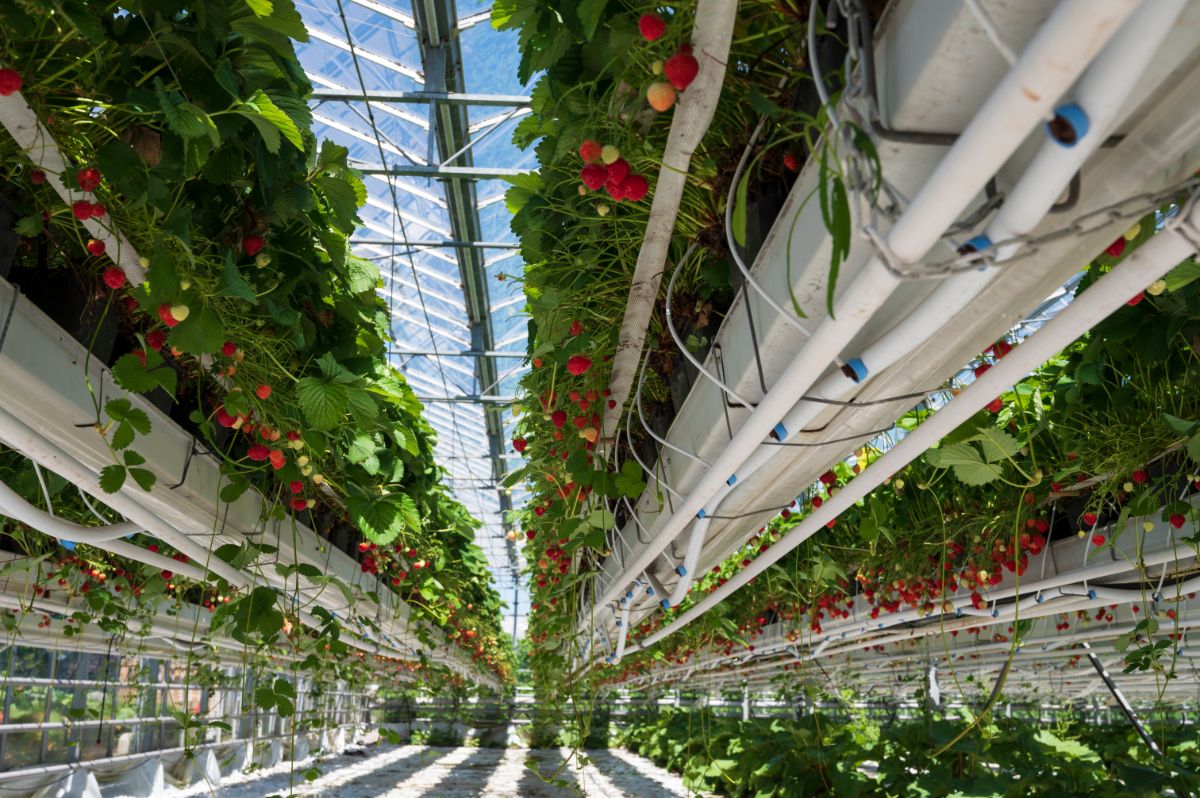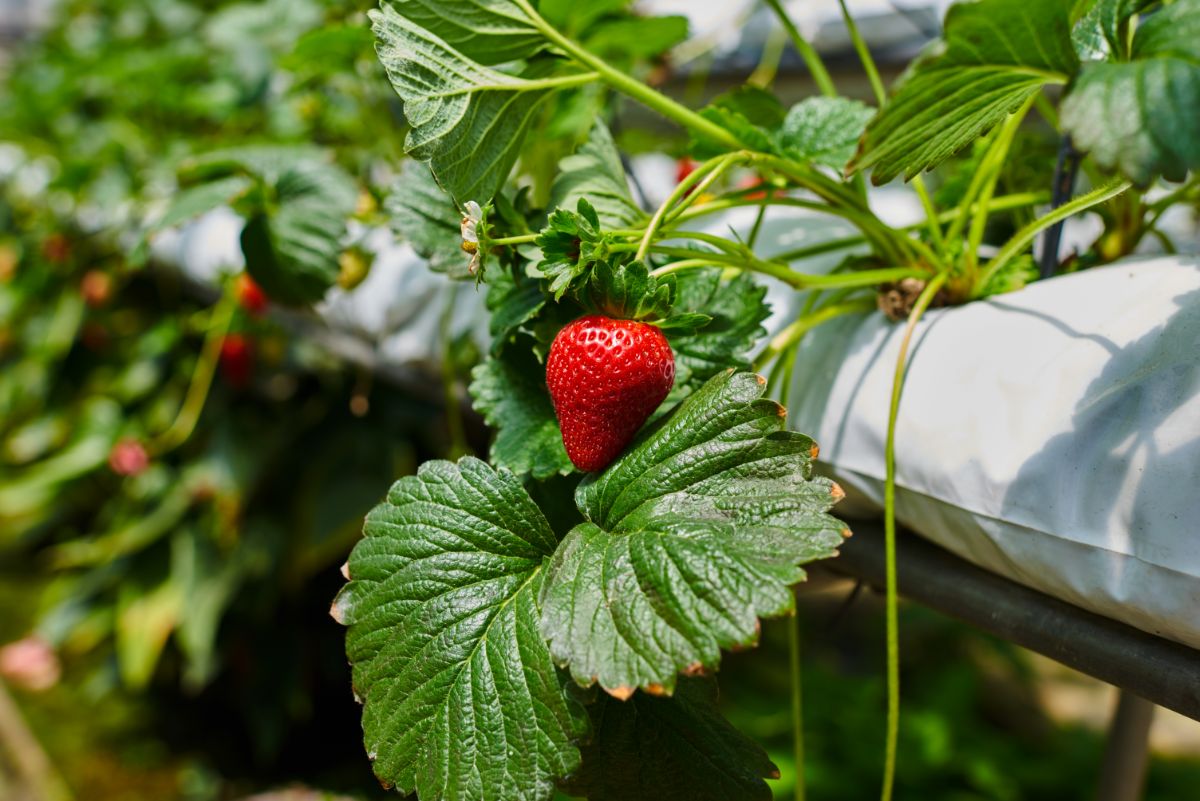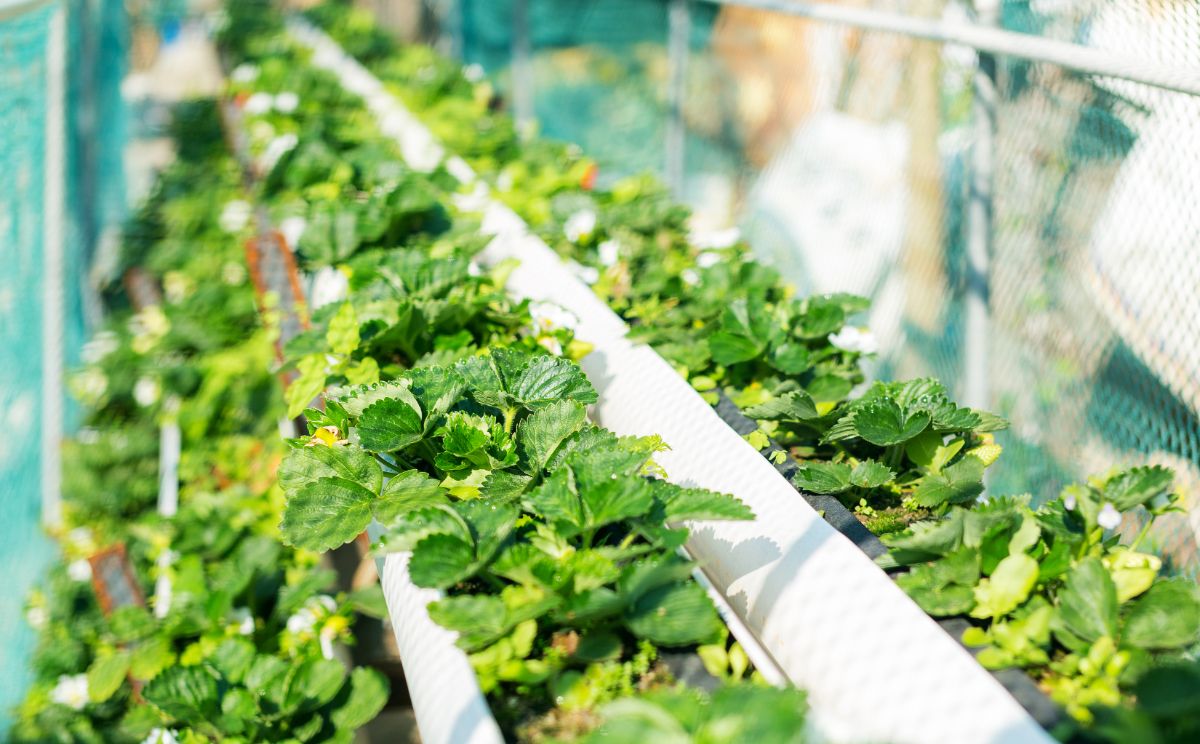Strawberry connoisseurs know the special pleasure of finding that one berry with sweet succulence, intense aroma, and overall “strawberrieness” that is often missing from mass-produced fruit. The quality of strawberries from both outdoor and greenhouse production can be quite variable. Sometimes strawberries turn out almost chewy. Sometimes strawberries are unevenly ripe, reek of odd odors and flavors, or have no flavor at all.

The good news is that defective strawberries are now preventable. Hydroponics gives growers the tools to control the inputs that make strawberry flavor sublime.
Jump to:
- Why Grow Strawberries Hydroponically?
- What Makes a Strawberry Sweet?
- What Gives a Strawberry Its Tart Taste?
- Strawberry Sweetness and Brix Levels
- What can growers do to increase Brix levels?
- Small Changes in Hydroponic Growing Media Can Make Big Changes in Strawberry Flavor
- Two Precautions for Using EC Readings for Growing Sweeter Strawberries
- Micronutrients Maximize Strawberry Flavor
- Do Strawberries Need Vitamins?
- What About Aromatics?
- Hydroponic Strawberry Production Is the Wave of the Future
Why Grow Strawberries Hydroponically?
Hydroponic strawberry production may have been around for thousands of years. We don’t really know what the ancient Babylonians planted in the hanging gardens of Nineveh, but we know that these plants grown in a continuous stream of nutrient-laden water could have included the berries of their time. We do know American soldiers grew strawberries and other plant crops in hydroponic farms on some of soilless islands of the Pacific in World War II.
More and more strawberry growers are investing in hydroponic systems to grow strawberries without soil. A major appeal of hydroponic strawberry culture is the freedom from the need to fumigate the soil with methyl bromide to kill the fungi and bacteria that interfere with maximum production of fruit. Hydroponic production is only under rare circumstances certifiably organic, but it is a lot healthier for consumers than traditional outdoor strawberry production in soil.

Hydroponic production systems conserve space. Entire strawberry farms can be stacked on shelves with a footprint of just 1000 square feet (a little over 90 square meters). Texas entrepreneurs Ana Buckman and Andrew Abendshein built an operation they call Acre in a Box from two shipping containers set in the parking of an abandoned drill bit factory in a food desert in Houston. Not only were there their startup costs astonishingly low — just $80,000 — their experience with Category 5 Hurricane Harvey pointed out another advantage of hydroponic production.
Acre in a Box was set up near the intersection of two bayous, the first places to flood in a major hurricane. For four days, Buckman and Abendshein could only monitor their operation by remote camera. They feared the worst from rising flood waters. But when the two hydroponics entrepreneurs finally made their way through the flood to check on their operation, they found that the shipping containers had only taken on about 10 inches (25 cm) of water, and they had only lost 5 percent of their crop. Everything else was fine.
Hydroponic operations shield strawberry growers from cold, heat, drought, and wind-borne diseases. They provide an opportunity to control conditions so a single planting can yield crops every other week for up to six months. With the right understanding of strawberry physiology, hydroponic growers can easily produce larger crops of strawberries. Producers can grow strawberries that are of the correct color, shape, and size for their customers.
Heavy production of beautiful berries is undoubtedly important We eat with our eyes first. We also shop with our eyes first. Strawberries have to be well-sized and visually attractive. But consumers who are now used to being able to buy beautiful strawberries year-round demand flavor.
What Makes a Strawberry Sweet?
The flavor of strawberries depends on a relatively small amount of dry matter. Strawberries average 92 percent water. Although the percentage of dry matter can range from 7 to 11-1/2 percent depending on age of the plant, cultivar, and plant nutrition, on average only 8 percent of the strawberry has the potential to contribute to flavor.
The sweetness of the strawberry derives from dissolved fructose and glucose. Tiny differences in the concentrations of these sugars can make a huge difference in taste.

These sugars in the strawberry are more concentrated on the side of the berry that receives more sun. The side of the berry that is grown in shade may have about 10 percent less sugar than the side of the berry that is grown in sun. The apex (the end of the strawberry farther away from the stem) may contain 50 percent more natural sugars than the peduncle (attached to the stem).
Fructose in fresh strawberries eaten by themselves is about 20 percent sweeter than table sugar, and fructose in strawberries and cream is 50 to 70 percent more intensely sweet than table sugar (sucrose).
Glucose in fresh strawberries produces added sweetness when the berries are eaten at room temperature. Strawberries eaten straight from the refrigerator will not taste as sweet because the tongue will be more sensitive to their texture and less sensitive to the contribution to the sweetness of the strawberry by glucose. Added cane sugar, of course, cancels out this effect. Added sugar makes strawberries taste sweeter but less like strawberries because it cancels out the flavor added by acids.
Strawberries also produce small amounts of sucrose, the form of sugar found in table sugar.
What Gives a Strawberry Its Tart Taste?
Ripe strawberries contain about 1.35 percent citric acid and malic acid. That’s a much lower part of a strawberry’s dry weight than its sugars.
For a strawberry to taste like a strawberry, it needs about six to nine times as much natural sugar as natural acid by weight. Unlike natural sugars, natural acids in a strawberry are evenly distributed throughout the fruit. The closer you nibble to the stem of the berry, the more natural tartness you will taste.
When you eat a strawberry in a single bite, you brain tends to register the last taste in a bite of food more strongly. If you bite into a berry stem side first and eat the sweeter end of the berry last, you will have more of a sweet taste sensation. If you bite down on a strawberry apex end first, it will taste sourer. The way you lay out a selection of strawberries, so guests eat the stem side first or the growing apex side first, has a significant effect on whether they experience them as tart or sweet.
It takes a lot of sweet to balance a little sour. But how do growers know when their strawberries are sweet enough?
Strawberry Sweetness and Brix Levels
Sweetness in fruits of all kinds is measured in units called Brix. Degrees Brix (°Bx) measures the total amount of sugar in a fruit’s juice compared to the fruit’s water content. For example, if a drop of strawberry juice contained 200 milligrams of sugars (fructose, glucose, and sucrose considered together) and 800 milligrams of water, its °Bx would be 100 times (to adjust the ratio to a percent) 200 / (200 + 800), or 20.
Watery fruit has a lower °Bx. Juicy but not too juicy fruit has a higher °Bx. For strawberries, a °Bx of 12 is OK, a °Bx of 14 is good, and a °Bx of 16 is great. Some very confident growers will even label their strawberries with °Bx readings when the °Bx is 16 or higher
How can growers measure Brix units?
Professional growers use a small device that looks something like a microscope or telescope to measure Brix. A drop of the fruit’s juice is placed in this refractometer, and °Bx is read as a number where a shadow falls on a scale.
What can growers do to increase Brix levels?

Hydroponic growers are in a better position than conventional or greenhouse growers to increase the sweetness of their crop.
Every grower wants small plants with heavy sets of fruit. For a small plant to support heavy fruiting, it must sustain a high rate of photosynthesis. Strawberries grown in shade don’t produce the same weight of fruit as strawberries grown in sun, and strawberries grown with the help of intense artificial light grow even more fruit than strawberries grown in full sun. Hydroponic growers who pay attention to light requirements get a bigger crop.
Growers can increase the sweetness of their strawberries by arranging light sources or supporting stems so that the entire berry is bathed in light. When both sides of a strawberry grow in full light, the berry produces more natural sugars.
The sweetness of a strawberry also depends on the nutrition delivered to the berry from the crown of the plant. Growers need to maximize leaf area of plants and also to ensure that leaves are bathed in light, whether natural sunlight or artificial light. The leaves support both the crown or the plant and the fruit, and the crown must be in good shape to take nutrition from the growing medium.
Small Changes in Hydroponic Growing Media Can Make Big Changes in Strawberry Flavor
Strawberries need different nutrients at different stages in their development to maximize sweetness.
Strawberries take up the nutrients they need through different chemical processes at different stages in their development. It’s not possible to optimize nutrition from the soil to maximize production of strawberries. Once you have prepared and amended the soil, your plants have to do their best with your efforts. But hydroponic growers can change their growing media in two ways to maximize the productivity of their plants and the sweetness of their berries.
Before strawberries flower and set fruit, they grow leaves. As mentioned earlier, the larger the leaves, the sweeter the fruit. Leaves respond to nitrogen. The hydroponic growing medium for strawberries in their early stages of growth needs to be higher in nitrogen. And for the plant’s roots to take up more nitrogen, the hydroponic growing medium needs to have a lower EC.
What’s EC?
EC is electrical conductivity. EC is measured in units called mScm-1 or milli-Siemens per centimeter.
A growing medium with a higher EC has lower resistance to the flow of mineral nutrients, such as potassium. A growing medium with a lower EC may be more conducive to the uptake of organic nutrients and nitrogen.
Strawberry plants need more nitrogen when they are growing leaves, before the blossom and set fruit. In this stage of their growth, they will need a growing medium that delivers more nitrogen. Nitrogen is more easily absorbed from a hydroponic solution that has a lower EC, usually around 1.2.
To maximize sweetness, strawberry plants need more potassium when they are setting fruit. Potassium helps cells in the berry absorb sugars produced in the leaves that flow through the sap in the stem to the berry.
Without enough potassium these sugars flow back into the sap of the stem. Potassium also helps the berry maintain fluid balance so it becomes juicy but not watery.
For the plant to absorb optimal amounts of potassium, the growing medium needs to have an EC of 2 to 3.2. The EC can be closer to 2 when the plants get maximal sunlight. It should be closer to 3 when plants are in shade or the weather is cloudy. The EC of the growing medium should be lower in low-humidity conditions and higher in high-humidity condition to reduce water stress on the plant.
Two Precautions for Using EC Readings for Growing Sweeter Strawberries
There is a common mistake growers make when they are measuring EC numbers. Readings of EC are only meaningful when the hydroponic medium has a constant pH. An EC measured when the growing medium has a pH of 5 will be entirely different from an EC when the growing medium has a pH of 9. And the meter has to be calibrated against a solution of known EC to make sure the meter itself isn’t fluctuating.
There is also a common mistake growers make in using EC numbers. When a hydroponic growing solution’s EC has been reduced to 70 percent of its original value (which means you need to measure EC before you use a growing solution), you should discard it. You can’t tell which nutrients have been removed by your plants, and if you guess wrong, you could be adding nitrogen after leaves have already been grown or potassium causing leaves to dry out. But nitrogen and potassium are not the only nutrients that affect strawberry flavor.
Micronutrients Maximize Strawberry Flavor

Horticultural scientists know a lot more about the roles of macronutrients such as nitrogen and potassium in the production of flavorful strawberries than they know about the roles of micronutrients such as boron, calcium, magnesium, molybdenum, silica, and zinc. But there are a few observations many strawberry growers make about micronutrients and flavor:
- Boron is essential for the elongation of the pollen tube to form the tiny seed on the surface of the strawberry.
- Boron, calcium, and zinc are essential for pollen formation. Strawberry plants that are deficient in these micronutrients don’t form the pollen they need for a heavy set of fruit. When a berry is only producing a few seeds, the plant does not need to produce a big berry. Without adequate levels of these elements, berries do not grow to normal size.
- Boron and molybdenum are needed for formation of both sugars and acids. These micronutrients are often deficient in tasteless strawberries.
- Calcium helps strawberries resist mold.
- Copper helps the plant use sugars for its own production of energy.
- Iron acts as a cofactor for some of the enzymes strawberry plants use to manufacture chlorophyll.
- Magnesium is essential for the production of chlorophyll. It’s a central part of the chlorophyll molecule.
- Silica helps roots take up both macronutrients (nitrogen, potassium, and phosphorus) and micronutrients (boron, calcium, magnesium, molybdenum, silica, and zinc.) more efficiently.
- Sulfur is essential for the plant’s production of the amino acids cysteine and methionine. Cysteine is a building block of DNA, and methionine is essential for the production of ethylene, which helps berries ripen.
When strawberry plants are young, they sometimes do not have the root mass they need to absorb necessary minerals from hydroponic solutions. Foliar sprays can ensure that growing strawberry plants get all the mineral nutrients they need for healthy leaves and tasty fruit. It is important to dilute these solutions appropriately to avoid burning leaves and killing plants.
Hydroponic growers can increase the distinctive strawberry flavors of their crops by arranging shelves and grow lights so plants are illuminated from all directions. They can make sure they boost potassium in the growing medium as the plants are just setting fruit, but reduce it slightly just before harvest.
Do Strawberries Need Vitamins?
We all know that vitamins are vital for the health of humans and animals. But are vitamins vital for plants?
As far as we know, there is never a time that a strawberry says to itself, “Some human is going to come along and eat my berries, so I had better be nutritious.” Strawberries make vitamins for their own health, not for ours. But many substances that are vital for human health are also vital for the health of the strawberry plant.
Strawberries make lots of vitamin C. They use vitamin C to help deal with water stress.
When a strawberry plant undergoes drought, it uses up its supply of vitamin C. Since there is no possibility of drought stress in hydroponic culture, strawberries raised hydroponically are a richer source of vitamin C. And since ascorbic acid is one of the natural compounds that makes strawberries tart, strawberries grown hydroponically have more naturally tart flavor.
Strawberries make folic acid (vitamin B9) in the process of making a compound called abscisic acid. Extensive research by scientists in China confirms that Increasing concentrations of this acid in turn sends a chemical message to the seeds on the surface of the berry telling them “Don’t sprout yet.” Strawberries that are fully ripe are higher in folic acid. Strawberries that are grown in full-light conditions, which light falling on both sides of the berry, make more folic acid.
What About Aromatics?
Strawberries produce some of the same aromatic compounds found in vine-ripened tomatoes and field-ripened pineapples. Part of the secret to producing strawberries with intense, distinctively fruity aroma — something so rare in mass-produced strawberries and sugar-laden strawberry products that many consumers are unfamiliar with it — is to favor small, more compact berries over larger, watery berries. The aroma of the strawberry is concentrated in its topmost layers, and on the side of the berry that has been exposed to the most sun. Larger berries have more flesh than “skin,” so they don’t have the intense aroma of smaller berries.
Another part of the secret to producing strawberries with a distinctively strawberry flavor is to make sure their growing medium includes traces of sulfur. The ethylene the berries make to ripen also activates the production of aromatic compounds that do not appear in the berry until it is fully red.
A third part of the secret to producing strawberries with the wonderful caramel aroma is to make sure all the trace minerals that occur in the soil in strawberry fields are included in the growing medium in the last week of production. Another group of scientists in China have confirmed that this wonderful scent is produced by the action of an enzyme known as 4-hydroxy-2,5-dimethyl-3(2H)-furanone, and sold as Furaneol. It cannot do its work without glucose, so those same horticultural practices that maximize sugar in the fruit will also increase the production of strawberry aroma.
Hydroponic Strawberry Production Is the Wave of the Future
The United Nations Food and Agriculture Organization estimates that there needs to be a 70 percent increase in food production by 2050. Vertical farming, such as is possible in the hydroponic production of strawberries, is one of the ways the world can meet this need.
Hydroponic strawberry growers avoid pests. They don’t compete with wildlife. They don’t need heavy equipment to till the soil. They can offer air-conditioned working conditions where workers do not to spend their days stooped over plants in vast fields. They can operate in small spaces in cities so their crops do not have to hauled long distances in diesel trucks. There is no methyl bromide contamination of the soil and no fertilizer runoff into streams and rivers. And with the right information, they can produce strawberries with longer shelf life and superior flavor.
Learn more about Hydroponics and growing strawberries indoors.










Nadya says
I bought a strawberry that have distinct artificial flavor (in my opinion). They are also very deep red. Do you think a producer can add something during growing process to have flavor enchanted to the point of being so unbearably artificial?
Brian says
I have 12 strawberry plants set up in an nft system. My problem is although the plants have/is flowering a lot, the actual berries wont ripen. They just seem to dry out. Also I find that the ph moves a lot from day to day. I do adjust daily to 6.0 but there are big swings in ph every day. Usually tends to go towards 5.5 or 5.4 so I raise it and the next day it has dropped again.
A previous batch I tried wouldn’t even flower. Also a lot of new leaves almost had burnt edges upon forming. This went on forever so I decided to let the runners run and I made the new 12 plants from them (and ditched the ‘parents’…(I know wrong term))
I have grown other plants hydroponically with success but just cant seem to get these strawberries to ripen.
Any thoughts?
Erick says
I’ve had some success at home with General Hydroponics nutrients (3 part kit) and growing from seeds – Simply Garden Strawberry Alpine Fresh Fruit Seeds Grow Your Own Garden (off Amazon)
I did have to pollinate the flowers, but I’ve had very sweet and tasty strawberries. (they are small but very good)
Boone says
Silica is a joke and should only be use sparingly if at all in hydroponics since it shows down photosynthesis and is use for drought resistance and keeps the plant from being able to kool down under high light ,high humidity and heat
brian welch says
Mr Strawberry, do you have any information on appropriate micronutrient levels? Specifically silica, I don’t have any number for this element. Is there much on indoor growing and hydroponic growing of strawberries in your book?
bronwyn says
what varieties are the sweetest and most flavorful that do well in a hydroponics system?
Mr. Strawberry says
Albion, Portola, and San Andreas are good choices.